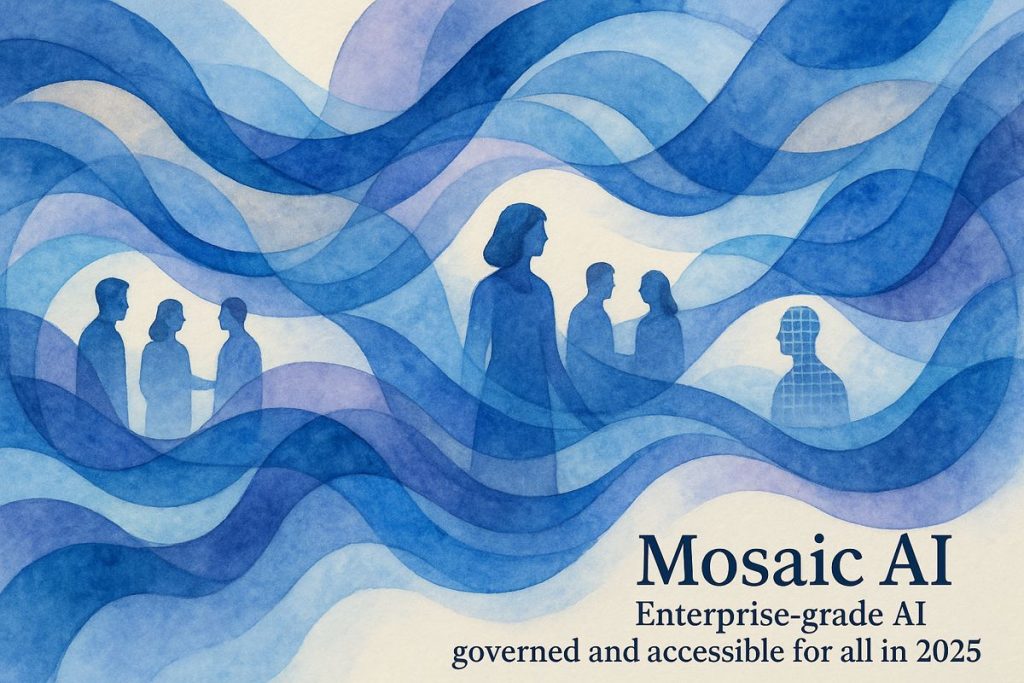Databricks Mosaic AI is a new platform shaking up enterprise AI by making it secure, transparent, and easy to use. It helps companies manage their data and AI models with strong safety and simple controls, so teams can innovate faster. With features like Agent Bricks and serverless GPUs, businesses can automate tricky tasks and scale up quickly. Mosaic AI also lets people use AI through plain SQL, making powerful tools available to more workers. The platform brings speed, smart insights, and a sense of excitement—turning enterprise AI from boring to bold.
What is Databricks Mosaic AI and how does it benefit enterprise AI?
Databricks Mosaic AI is a platform designed for enterprise AI, offering robust governance, security, and transparent audit trails. It simplifies workflows with Agent Bricks, enables serverless GPU compute for scalable performance, and integrates AI directly with SQL, boosting innovation and efficiency in sectors like pharma and manufacturing.
Where Governance Meets Guts
Let me level with you: it wasn’t so long ago that “enterprise AI” conjured up images of labyrinthine compliance checklists and meetings where everyone’s eyes glazed over exactly three minutes in. Now, with Databricks’ Mosaic AI platform muscling its way onto the scene, things finally smell different—like ground espresso and something burning (my toast, probably). Mosaic AI is flipping the script for sectors like pharma, life sciences, and those eternal pragmatists in manufacturing. The platform’s latest features? Think of them as the hyperspectral goggles science fiction always promised us, now tailored for the modern C-suite. Security and governance aren’t afterthoughts here; they’re baked in, like the bittersweet char at the bottom of a moka pot.
At the heart of this tectonic shift is the Mosaic AI Gateway. This isn’t just a velvet rope for your LLM endpoints; it’s an impassable palisade. Every API call—every whisper between your models and the world—is logged with forensic precision in Delta tables, all under the unwavering gaze of Unity Catalog. If you’ve ever tried reconstructing a research audit trail from scratch, you’ll feel a pang of relief (and maybe a pinch of envy) at how transparent it’s become. AI guardrails? They’re not just theoretical. If your model so much as hints at going off-piste—hello, regulatory fines!—the platform’s built-in sentinels steer it right back.
But, does this level of monitoring slow enterprise creativity? I had to stop and ask myself that. In my last data engineering role, my team once spent two days untangling a permissions mess that could’ve been solved in minutes here. The result? Less bureaucratic entropy, more time for innovation (and strong coffee).
Agents With Brains—and Maybe a Sense of Humor
Now, Agent Bricks. Remember the first time you saw a robot vacuum and thought, “Could this thing actually replace my cleaning habits?”—well, Agent Bricks are like those vacuums, but for your most knotted operational workflows. With a few natural language prompts, you orchestrate agents capable of extracting insights from patent archives or synthesizing quarterly reports. No more yak shaving, no more endless meetings trying to stitch together five separate systems just to answer one question.
The trick, oddly, is in the continuous, almost neurotic, improvement loop. Mosaic’s own AI-powered “judges” are perched atop your workflows, evaluating every output with an obsessive attention to quality. If something breaks? No need for an all-hands panic—debug, redeploy, and get back on the horse. (I do wonder if these judges ever get tired. Machines, right?)
Once, I set an Agent Brick loose on a decade’s worth of R&D notes at my lab. For the first time, silent patterns surfaced: a forgotten patent application, a phrase in a 2014 notebook that suddenly connected three current projects. I felt a jolt—real intellectual delight—followed by a sheepish “why didn’t I try this sooner?”
Hardware Alchemy, SQL Sorcery
Here’s where the magic sharpens its teeth: Serverless GPU Compute. Once upon a time, provisioning GPUs was a grim ordeal, somewhere between taming Kafkaesque bureaucracy and winning the lottery. Now? Mosaic AI spins up (and down) those compute resources automatically, matching your needs whether it’s a tiny prototype or a herculean production inference workload. Pay only for what you use. The sound of spinning fans as racks boot up, the faint ozone of fresh hardware—gone. Just pure, cost-efficient elasticity.
What’s more, Mosaic plugs AI straight into SQL. Business analysts, those perennial spreadsheet gladiators, can now wield generative AI and information retrieval without ever touching Python. It’s like giving them hyperspectral vision, or at least a really good monocle. Storage optimizations have boosted speeds, making analytics in real time feel less like wishful thinking and more like Tuesday morning routine. Bam!
I’ll admit, I once doubted SQL could ever be a meaningful AI interface. Wrong. Turns out, the only thing slower than a reluctant DBA is me, when I ignore the march of progress. Lesson learned (again).
Mosaic’s New Tapestry: RAG, Vectors, and a Dash of MLflow
Retrieval-Augmented Generation (RAG) isn’t just for chatbot demos anymore. Mosaic has woven RAG applications into its fabric, letting companies like Corning dredge up actionable insights from thousands of patent filings—sometimes in seconds, not hours. Built-in vector search flies through terabytes of unstructured data (text, image, or video), bringing those eureka moments within reach, especially for overworked R&D teams.
And then there’s MLflow 3.0, now shinier and more panoramic than ever. Unified lifecycle management for generative models—across Databricks, AWS, GCP, on-prem—means you get the same observability, no matter your cloud allegiance. Centralized dashboards, advanced metrics, and real-time pipelines: all stitched together like some vast, humming palimpsest.
I’ll leave you with this: the energy around Mosaic AI is palpable, like the late-afternoon hum in a startup kitchen or the faint, metallic tang of anticipation before a big release. If you’re ready to dive deeper, the Databricks Blog, AIM Research, and this Decube rundown offer layers more detail—and probably fewer coffee stains than my notes.
Will Mosaic solve every enterprise AI headache? Maybe not. But for once, the risk feels worth the buzz. Or maybe that’s just the caffeine talking…
